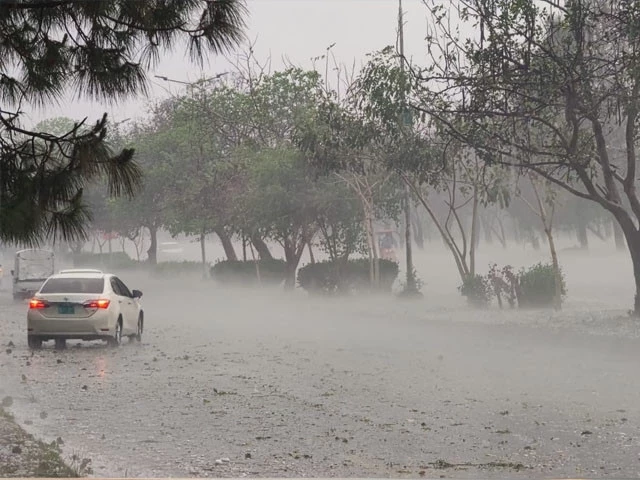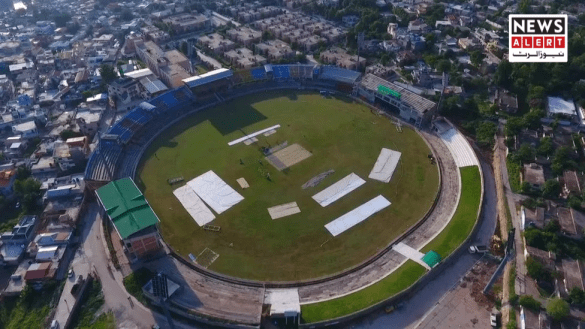Widespread Weather Alert Issued
Pakistan’s Meteorological Department has forecast thunderstorms and rain across several northern and central regions of the country. Strong winds and lightning are expected in parts of Khyber Pakhtunkhwa, Islamabad, the Potohar region, Kashmir, and Gilgit-Baltistan.
In contrast, most southern and western areas are likely to experience hot and dry conditions, with only isolated showers predicted. The weather alert reflects Pakistan’s diverse climatic zones, where summer often brings sharp variations between the north and south.
Cities Likely to Receive Rain
According to the forecast, the capital Islamabad is bracing for thunderstorms accompanied by gusty winds. Neighboring cities, including Rawalpindi, Murree, Galliyat, Jhelum, Attock, Chakwal, Lahore, Sialkot, Narowal, Gujrat, and Gujranwala, are also likely to receive rainfall. In Punjab, authorities are already on alert for intense downpours, with officials warning of possible flooding during upcoming monsoon spells. More details can be found in Punjab on High Alert as 10th Monsoon Spell Approaches.
In Khyber Pakhtunkhwa, rain and thunderstorms are predicted in Dir, Swat, Kohistan, Shangla, Battagram, Mansehra, Abbottabad, Haripur, Bajaur, Mohmand, Orakzai, and Khyber districts. The Meteorological Department has warned that sudden downpours in hilly areas could trigger landslides or localized flooding.
Conditions in Southern Provinces
In Balochistan, southern districts are expected to remain partly cloudy, though no significant rainfall has been forecast. Meanwhile, Sindh’s coastal belt — including Karachi and adjoining towns — could see light rain at isolated spots, offering some relief from the humid conditions.
The forecast also includes Azad Kashmir and Gilgit-Baltistan, where residents should prepare for strong winds and scattered showers. These regions, prone to landslides during wet weather, may face travel disruptions on mountain roads.
Recent Weather Trends
Over the past 24 hours, most parts of the country remained hot and dry, with temperatures rising above seasonal averages in Sindh and southern Punjab. However, Islamabad, parts of upper Punjab, Khyber Pakhtunkhwa, and Kashmir recorded rainfall, providing temporary respite from the heat.
In Swat and surrounding areas, a minor earthquake was also felt, causing panic among residents. Although no casualties or damage were reported, the tremors highlighted the region’s vulnerability to seismic activity. Northern Pakistan lies along a tectonic fault line, making it one of the country’s most earthquake-prone zones.
Climate Context
Pakistan frequently experiences erratic weather patterns during the pre-monsoon season. Thunderstorms, dust storms, and sudden downpours are common between May and July, often disrupting daily life.
According to climate experts, rising global temperatures are making Pakistan’s weather more unpredictable. Intense heat waves in the south can occur alongside heavy rainfall in the north, straining infrastructure and disaster response systems.
Advisory for Citizens
Authorities have advised citizens to remain cautious during thunderstorms. Travelers in northern districts are urged to check weather updates before planning road journeys, especially in areas prone to landslides or flash floods.
Residents in Islamabad, Rawalpindi, and Lahore have also been asked to stay alert for urban flooding in low-lying neighborhoods if heavy showers occur. Meanwhile, farmers in Punjab have been told to take precautions to protect standing crops from unexpected rainfall.
Outlook
The Meteorological Department will continue to monitor developments as the monsoon season approaches in July. Officials say more detailed forecasts will be issued in the coming weeks, particularly for flood-prone areas.
For now, northern Pakistan can expect spells of rain and thunderstorms, while the south remains largely hot, dry, and humid. This sharp contrast underscores the challenges faced by Pakistan in managing weather extremes within a single season.















